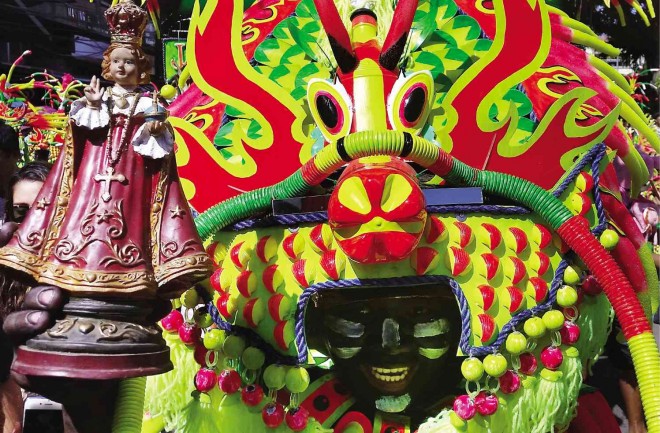
KALIBO, AKLAN—Hernany Lao lined up along with hundreds of devotees at the St. John the Baptist Cathedral here. When his turn came, a lay worker placed the feet of a six-inch wooden image of the Child Jesus Sto Niño de Kalibo on Lao’s head and gently moved it to other parts of his body.
“I prayed that I would be cured of diabetes,” Lao said, adding he has participated in this healing ritual known as “paepak” (to be stepped on) for the past 50 years.
The paepak is one of the highlights of the annual Ati-atihan festival, one of the oldest and most popular festivals on Panay island, which will culminate this weekend with its well-known street dancing contests and general revelry.
But for many ordinary people who trek to Kalibo every third weekend of January, the come-on is the paepak ritual and devotion to the Sto Niño de Kalibo. Since Jan. 8, throngs of devotees have been lining up at designated stations, open from from
6:30 a.m. to 7 p.m.
Editha Macahindog, 25, of the neighboring town of Banga, came with her husband and two children. “We try to come here every year. We only fail to be at the paepak when there are too many people and the lines are very long,” she said. They brought their 1-year-old son, Nikko Jay, who was coughing, and daughter Neskierubin, 4, who suffers from asthma.
“I pray that they will recover from their ailments,” Macahindog said.
For healing and protection
Lay workers who administer the rite noted that more devotees had come for this year’s paepak and Ati-atihan.
The devotees, many with loved ones with disabilities and ailments in tow, pray for healing and for protection against disease. Devotees also bring their own images of the Sto Niño and other religious items to have them blessed by priests.
Chona Sobremesana, 59, who joined the festival for the first time, traveled from Bacolod City with a friend and former classmate.
“I felt compelled to come here. Maybe it’s a call from the Lord,” she said. Unlike other festivals, there is a deep sense of religiosity in the Ati-atihan and the focus is on one’s faith, she said. Chona bought a 12-inch image of the Sto. Niño which she had blessed by Fr. Joesel Quan, one of eight priests at the cathedral.
Quan said devotees had come from as far as Catanduanes and other parts of the country.
Street dancing contests
Meanwhile, the street dancing contest was under way. On Saturday, 29 tribes competed in the Ati tribe street dancing contest on the main streets of the town. Seven tribes competed under the Modern category or those using contemporary costumes and props.
Eight tribes joined the Balik-Ati category or those that use indigenous materials such as abaca fibers, shell, and feathers and leaves. The Tribal Small category (maximum of 60 warriors) had six competing tribes while the Tribal Big (more than 60 and maximum of 120 warriors) had eight participants.
The winners will be announced on Sunday evening.
On Sunday morning, a Mass will be celebrated by Kalibo Bishop Jose Corazon Tala-oc in front of the cathedral. In the afternoon, a religious procession and street dancing are expected to be joined by tens of thousands of devotees and revelers hoisting images of the Sto. Niño on the main streets of Kalibo. The procession, expected to last at least eight hours, will culminate on the grounds of the cathedral.
RELATED STORIES